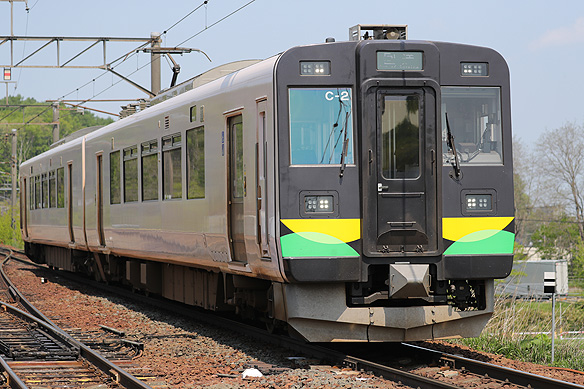Background and overview
In 2023, JR Hokkaido introduced the 737 series AC electric multiple unit (EMU) commuter trains to replace aging rolling stock on key regional routes. These new trains were deployed to supersede the KiHa 143 diesel multiple units (DMUs) operating on the Muroran Line between Tomakomai and Muroran, as well as the first-generation 721 series EMUs serving the Sapporo area. A total of 13 two-car trainsets were delivered, each consisting of one motorized end car and one non-powered trailer end car.
Car body
The vehicles feature a narrow-profile car body constructed from double-skinned aluminum alloy, measuring 21,030 mm in length—120 mm shorter than the previous JR Hokkaido EMU—and 2,800 mm in width, with a bogie centre distance of 14,400 mm.
The cab ends are fabricated from steel and bolted to the main aluminum structure. They incorporate a reinforced gangway connection base, a swept-back profile, and a cage-type structure designed to protect against obstacles at level crossings.
Each cab end is gangwayed, featuring a gangway door and a low-positioned driver's cab to support conductor-less operation. Flat windscreens are adopted to reduce manufacturing costs. Above the gangway door, a colour-selectable LED destination display is installed. Clusters of headlights and taillights are mounted above the windscreens, with additional headlights positioned below.
The floor level is set 100 mm lower than that of the 731 series to eliminate the doorway step and improve accessibility. The exterior livery of the 737 series consists of a pale pink base colour, with black cab ends accented by olive green and yellow highlights.
Each car is equipped with two 1,200 mm-wide single-leaf semi-automatic sliding doors, which can also be operated manually via push buttons located adjacent to each door.
Between the doors, three centrally positioned windows measuring 1,990 mm in width are installed. Each consists of a two-part hopper-style upper sash and a large fixed lower sash. These central windows are flanked on both sides by fixed windows measuring 1,585 mm in width.
To increase passenger space, the snow separator louvers found on powered vehicles have been eliminated through the adoption of fully enclosed traction motors.
Each car is fitted with a colour-selectable LED destination display and a loudspeaker on both sides. An N-AU735 air conditioning unit, rated at 30,000 kcal/h, is mounted at the centre of the roof.
To prevent snow and ice accumulation, 1 mm-thick stainless steel cover plates are installed between underfloor equipment, reducing surface undulation and improving winter performance.
Bogies
The motored bogies are designated N-DT737, while the trailer bogies are type N-TR737. These trailer bogies incorporate bolster-less secondary air suspension, a trailing arm link journal box support system, and a single-link traction mechanism. To reduce the floor height, the wheel diameter has been minimized to 810?mm, and an arched bogie frame is adopted.
For enhanced ride quality at speeds up to 120 km/h, all bogies are equipped with yaw dampers. Power transmission is achieved via the Westinghouse-Natal drive system, featuring a gear ratio of 5.22.
Both motored and trailer bogies utilize a double-tread brake unit fitted with high-adhesion alloy cast iron brake shoes. An automatic gap-adjusting mechanism is also integrated to maintain optimal braking performance.
Traction unit and ancillary equipments
Class Kumoha737 vehicles are equipped with the N-CI737 traction system,
which controls four totally enclosed AC asynchronous motors (type N-MT737),
each rated at 190 kW. A shell-type traction transformer (N-TM735-AN), mounted
beneath the floor and cooled by traveling wind, supplies power to the system.
Current collection is performed via a single-arm pantograph (N-PS785) installed
on the roof.
The traction system comprises a three-level PWM converter and a two-level variable-frequency drive (VFD), both utilizing hybrid SiC (silicon carbide) power modules to enable system miniaturization.
Class Kuha737 vehicles are fitted with a motor-driven air compressor (N-MH1785-C2000ML) and two auxiliary power supply units (N-APS-735) for AC and DC loads. These auxiliary systems consist of a converter that combines a diode bridge and a chopper circuit with IGBT switching devices, powered by the tertiary winding of the traction transformer, and an inverter.
The braking system is an electrically commanded brake with regenerative braking capability down to zero speed. It features trailer-priority brake control logic to optimize braking performance across the trainset. The train's transmission system utilizes ARCNET for reliable and deterministic data communication between onboard subsystems.
Accommodation
Passenger seating consists of longitudinal bench seats arranged in a 3-5-3 configuration, with an individual seat width of 460 mm. Stanchions are installed at both ends and at the centre of each bench to assist standing passengers. Enlarged wind protection panels are fitted at both ends of the benches to reduce cold air intrusion.
A designated free space is provided for wheelchairs, strollers, and large baggage. An air-conditioning duct is installed above the ceiling, featuring slit-shaped vents designed to enhance the interior appearance. Illumination is provided by two rows of LED light fixtures, and hanging straps are installed throughout the car.
Each door head is equipped with a door chime and flashing warning lamps that activate during door opening and closing. Behind the driver's cab, a ticket machine (which issues boarding station tickets), LCD fare chart displays, and fare boxes are installed.
Kuha737 cars are equipped with a universal access toilet employing a vacuum-type system, along with a wheelchair space.
The driving cab features a single-handle master controller operated with the left hand. The gangway door window and the co-driver's side windshield are made of polycarbonate with a surface heating function, which provides snow-melting and anti-condensation effects.
Operations
Revenue service for the 737 series commenced in 2024. The trains were introduced
on the Chitose and Muroran Lines, operating between Sapporo and Muroran,
as well as on the Hakodate Line between Iwamizawa and Asahikawa. |
|

